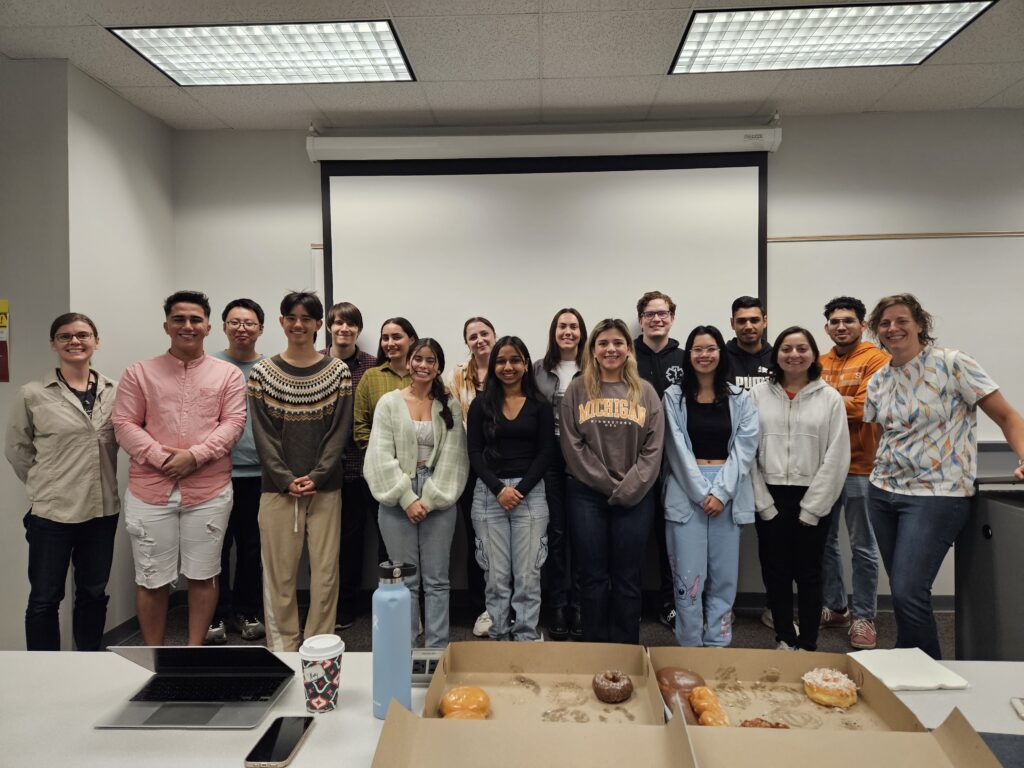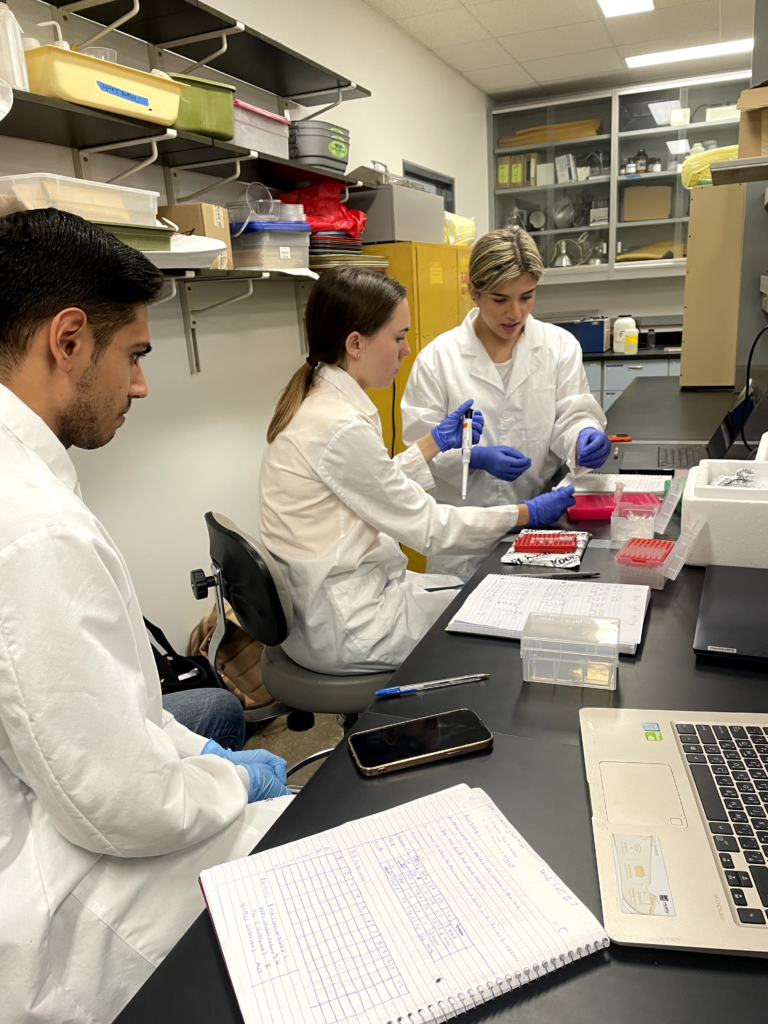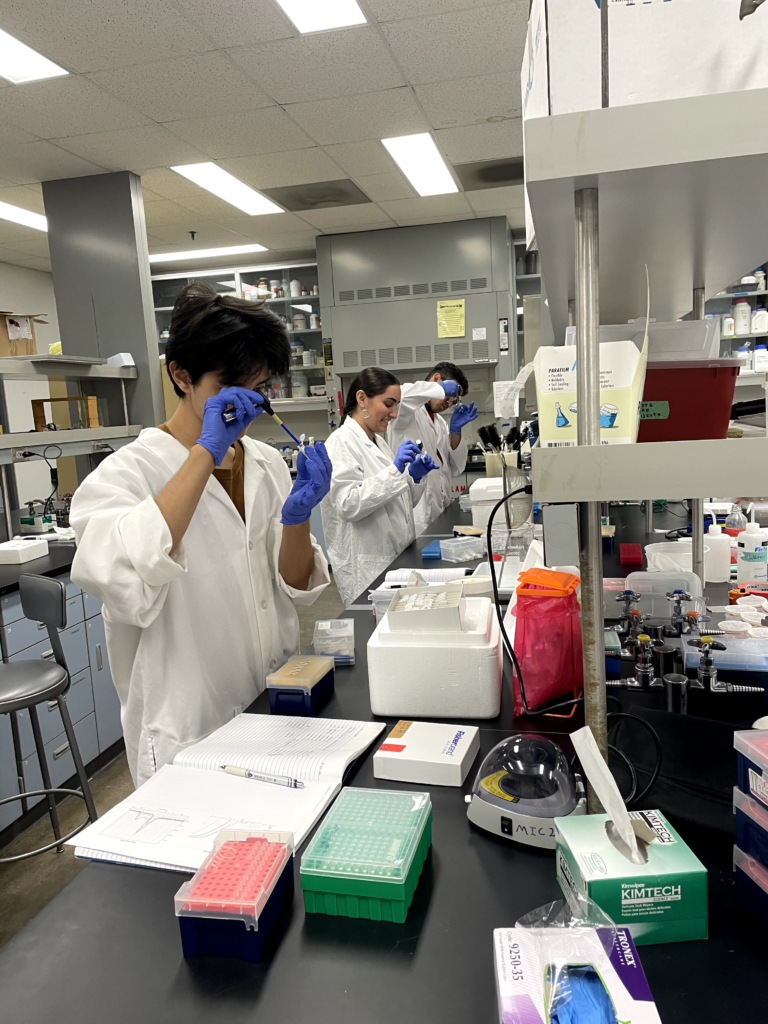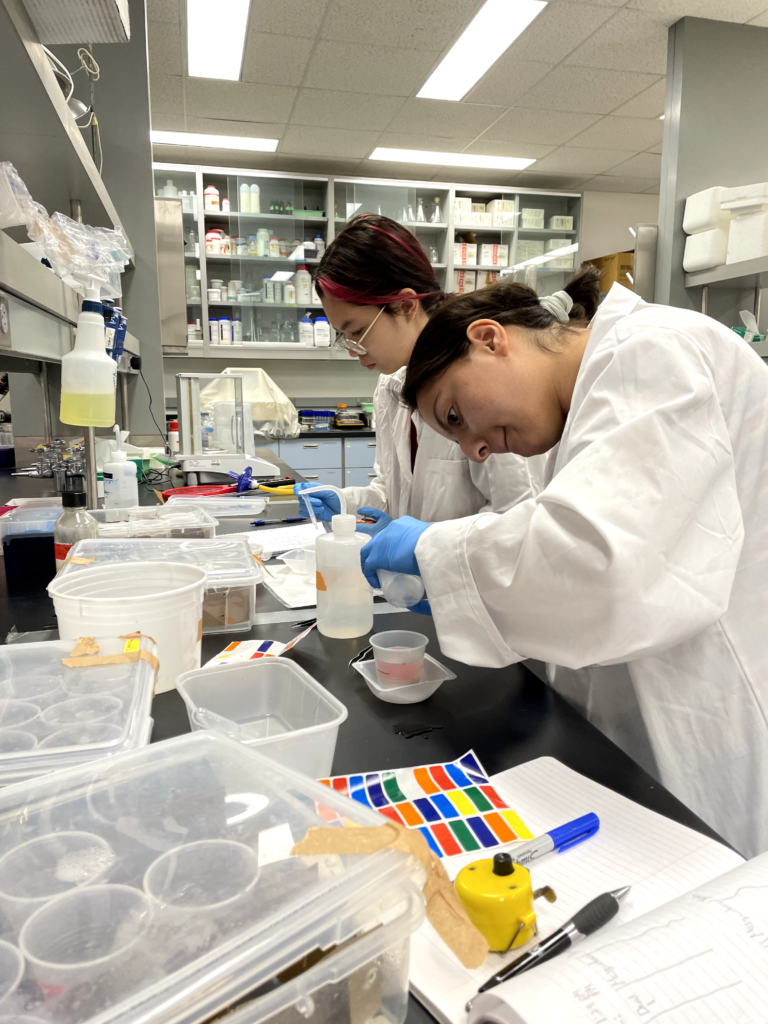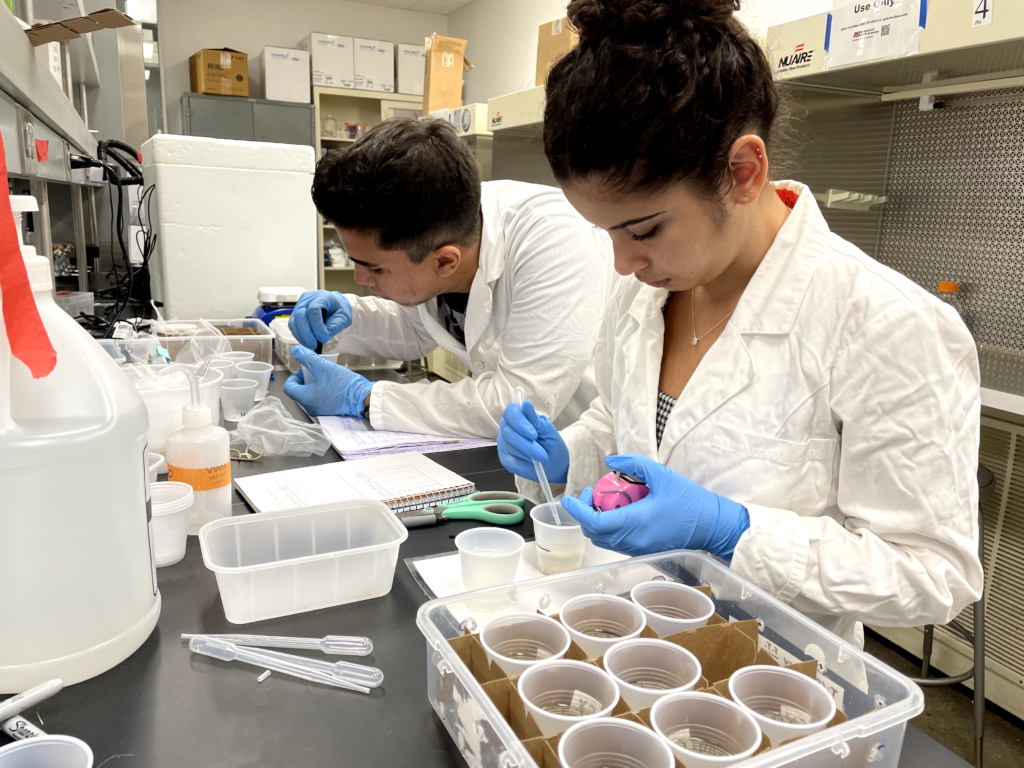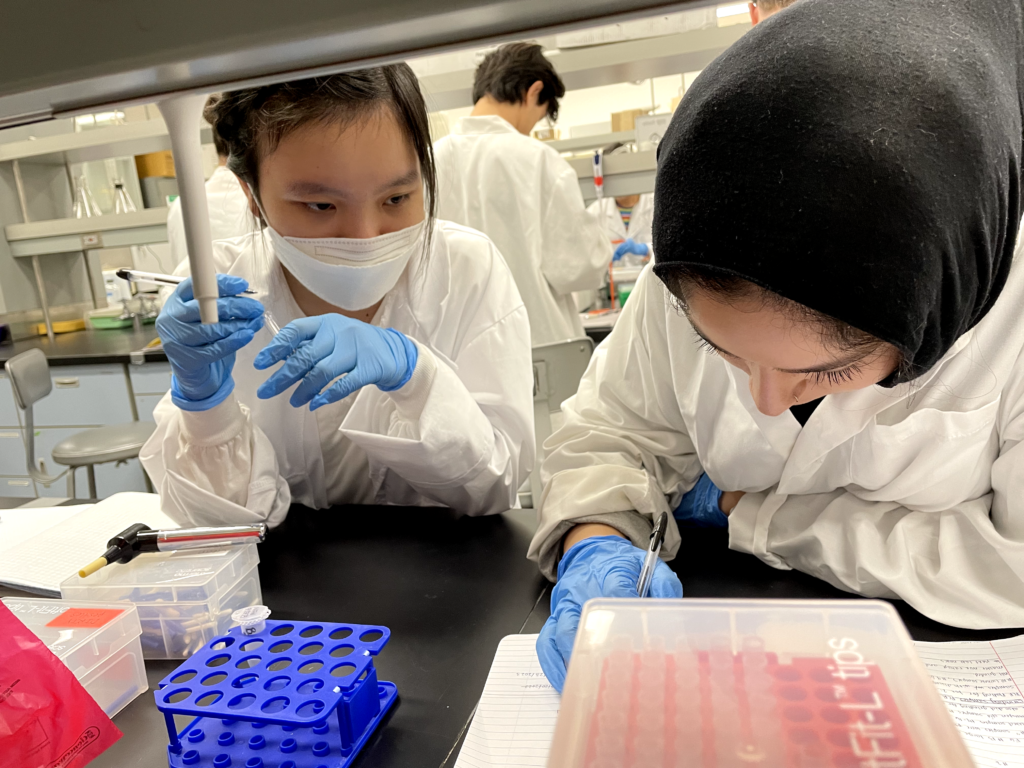In fall semester of 2023 I ran a CURE (course-based undergraduate research experience). The goal of this course was for students to get first-hand experience in performing research. They would be learning about the scientific process, mosquito biology and various research methodologies. We wanted these students to get true research experience, so they’d be working on current research projects in the lab, rather than cookie cutter labs for which we already knew the outcome. The course did not assume any prior research experience, in fact we preferentially enrolled students without prior research experience. In addition, we preferentially enrolled students from historically underrepresented groups.
Class structure
The course consisted of a weekly 75 minute ‘lecture’, and three times 2.5hr lab time. During the lecture portion, we discussed important research skills, such as experimental design, reading and critiquing papers, literature search, data visualization, statistics, and scientific presentations. In addition, we covered important topics around mosquito ecology and evolution, vector-borne diseases, and genetic tools. During lab time, students worked in teams of two or three on their assigned research projects. Our class had 17 students, which we split in seven teams of 2 and one team of three. We had 4 different types of projects, which we presented on the first day of class. All students had either their first or second choice of project. Our class had an assigned TA for this course (20hrs/week), which was a graduate student in my lab who developed the research projects to fall within the topic of her dissertation. In addition, this semester we had a Master student intern (10hrs/week) who helped with lab preparations, supervising lab and conduct some grading. During the first few weeks, having three instructors available to teach students all the lab skills was necessary. After the initial steep learning curve that lasted about 3-4 weeks, we just had a single instructor available during lab to provide help and answer any questions.
Projects
We had four different types of projects that students were working on. The aim of the first project was to determine the effect of extreme temperatures on the fitness cost associated with insecticide-resistance as expressed in Aedes aegypti larvae. Students were rearing larvae of three different kdr genotypes (homozygous resistant, homozygous susceptible and heterozygous) at a cold and hot temperature in make-shift Styrofoam incubators. The aim of the second project was to determine the effect of larval density on the fitness cost in Ae. aegypti larvae. The same genotypes were used as in the first project, but instead of temperature as the variable, low and high larval density was tested. Each of these projects had two teams assigned to them and each team conducted the experiment twice to have internal replication. The other two projects were based on genetic analysis of stored mosquito samples. One project involved genetic surveillance of insecticide-resistance markers of field-collected Ae aegypti mosquitoes. The other project involved genetic identification of experimental mosquitoes in a long-term evolution experiment to determine changes in allele frequency over time.
The data that the students collected was generally good quality and will be used in future scientific presentations and publications. Students will be co-authors of any poster/paper that will include data that they collected.
Grading
Students were graded on individual assignments for 20% over their overall grade. These assignments involved practicing skills such as reading and understanding scientific papers, finding scientific literature, pipette handling, creating clear methodology diagrams, and, at the end of the course, creating a curriculum vitae featuring the research experience from this CURE. Another 20% of their overall grade were based on their lab notebooks. These notebooks were not allowed to leave the lab and students were given clear instruction and a rubric on how to maintain their notebooks. Notebooks were graded four times throughout the semester without prior notification when this would take place to encourage students to have their notebooks up to date at all times. As a team, students submitted progress reports throughout the semester, which counted for 40% of their grade. The topics of their progress reports were: 1. Experimental plan, 2. Setup of database, 3. Graphs of their first results, 4. Results and conclusions of their final results, 5. Discussion. There was an optional 6th progress report with statistical analysis for extra credit. The final 20% of their grade was for their final presentation.
Student population
We preferentially enrolled students from minority backgrounds and those who did not have previous research experience. Fifteen out of 17 students reported not having any prior research experience. We had a great diversity among our students. Gender distribution was 41% identifying as male and 59% as female. Ethnic diversity was large as well with 24% identifying as white, 18% as Asian American, 18% as Hispanic, 18% as Middle Eastern, 18% as ‘other’ and 1 responded preferring not to disclose. Most of our students were juniors (47%) or seniors (47%) with one sophomore.
Impact
We asked students to complete a pre- and post-course survey to determine the impact of the course on their sense of belonging in research, see results in table 1. Overall, the post-course survey scored higher on every question. Students increased by more than one point on likert scale on their level of confidence in their technical science skills and ability to generate research questions. We also saw strong increases in their confidence regarding data collection and use of literature. At the start of the course, students reported low on the question ‘I have come to think of myself as a scientist’, with an average 3.29, at the end of the course this increased to 4.29. There were no real changes observed in terms of pursuit of a science-related research career (3.94 in pre-course survey, 4.0 in post-course survey).
Table 1. Results from pre- and post-course survey of students in course (100% response rate). Questions were asked on a likert scale of 1 (low confidence/not like me) to 5 (high confidence/much like me).
| Question | Pre-course survey | Post-course survey | Difference |
| How confident are you in your ability to use technical science skills (use of tools, instruments, and/or techniques) | 3.41 | 4.47 | +1.06 |
| How confident are you in your ability to generate a research question to answer | 3.0 | 4.18 | +1.18 |
| How confident are you in your ability to figure out what data/observations to collect and how to collect them | 3.35 | 4.29 | +0.94 |
| How confident are you in your ability to use scientific literature and/or reports to guide research | 3.53 | 4.12 | +0.59 |
| I have a strong sense of belonging to the community of scientists | 3.76 | 4.29 | +0.53 |
| I have come to think of myself as a ‘scientist’ | 3.29 | 4.12 | +0.83 |
| I feel like I belong in the field of science | 4.18 | 4.53 | +0.35 |
| How much is the person in the description like you? A person who thinks it is valuable to conduct research that builds the world’s scientific knowledge | 4.41 | 4.65 | +0.24 |
| How much is the person in the description like you? A person who feels discovering something new in the sciences is thrilling | 4.65 | 4.82 | +0.17 |
| To what extent do you intend to pursue a science-related research career? Assess from 1 (definitely will not) to 5 (definitely will) | 3.94 | 4.0 | +0.06 |
The course had further impact on students with a total of seven students joining the lab in the following semester to continue to work on the research projects they started and/or contribute to different research projects.
Student feedback
Overall, students reported throughout the course that they greatly enjoyed this course and thought it was very beneficial to them. Course evaluations showed an average 1.19 for the course (1 is highest, 5 is lowest) and 1.13 for instructor.
Below a few selected responses from students in course reflection and course evaluation
“This course was different from any other course I have taken. It was a great opportunity to get some research experience while also feeling like it was okay to be a beginner and make mistakes. I feel like this allowed me to be comfortable and learn.”
“Honestly, everything about this course was perfect! I loved how we were all placed into teams, and everyone worked together to reach a certain conclusion about the data we collected. The sense of collaboration made the class feel like a big family, and I appreciated how everyone was willing to help one another out.”
“I personally never thought that I would enjoy the research experience for the reason that I was not confident enough in my abilities and I always thought that research is hard and complicated and not enjoyable. However, the experience of taking this course changed my mind completely I learned that people who are smarter than me can make mistakes in the process of doing an experiment which helped me to not punish myself mentally when I do a mistakes”
“I consistently found myself putting in more effort than I probably needed to for this course, simply out of curiosity and enjoyment.”
“It was rewarding to see how far we have come from being uncertain about what we were doing at the beginning of September, to be capable of articulating our concerns about which samples need to be rerun or whether our interpretations need to be reexamined because we started to gain confidence in our skills”
“I feel more passionate about research now, and want to pursue a career in a research setting”
Concluding remarks
Overall, this course was very rewarding to teach. It was a relatively large time investment, but it was a great pleasure to see the confidence, skills, and enthusiasm grow over the course of the semester. I would not have been able to teach this course without support of at least one TA. Particularly at the start of the semester, there is a lot of hands-on training for which we needed at least three instructors/TAs. The way we set up the course, there were different skills that needed to be taught to different groups, therefore, to get everyone going, it is helpful to have multiple people to focus on different groups.
There was certainly a pay-off in the time investment beyond student learning. The data collected in our course is used in the graduate thesis of the PhD student and will be included in various publications. Overall, this course was a win-win for both the instructors and the students and we plan to repeat the course in the next fall semester.
Pictures
